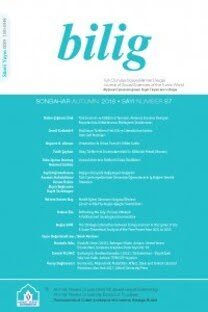The Kashkay People, Past and Present
İran'da Türkçe konuşan bir halk olan Kaşkaylar, 20. yy.ın ba-şından beri önemli bir araştırma konusu olmuştur. Bu makale, bu top-luluk hakkında bazı genel bilgiler (örn. coğrafi, sosyo-etnik ve tarihi) vermeyi amaçlamaktadır. Kaşkayların tarihi hakkında bilgi vermek icin yazar, bu topluluğun İran'ın güneyindeki Türk topluluklara kadar giden kökleri üzerinde durmaktadır.
Geçmişten Günümüze Kaşkaylar
The Kashkay, a Turkic-speaking people living in Iran, have been the subject of scholarly research since the beginning of 20th century. This article aims at providing some general (e.g. geographical, socio-ethnological and historical) data on this people. To give an overview of the history of the Kashkay people, the author traces back its roots to the early times of Turkic presence in the south of Iran.
___
Beck, Lois (1986). The Qashqa'i of Iran. New Haven. Conn: Yale University Press.(1991). Nomad: A year in the life of a Qashqa'i tribesman in Iran. Berkeley: University of California Press.
Boyle, J. Andrew (1968). The Cambridge History of Iran. 5. The Saljuq and Mongol Periods. Cambridge: University Press.
(1986). The Cambridge History of Iran. 6. The Timurid and Safavid Periods. Cambridge: University Press.
(1991). The Cambridge History of Iran. 7. From Nadir Shah to Islamic Re-public. Cambridge: University Press.
Csató, Éva A. (2001). "Present in Kashkay".Turkic Languages 5: 104-119.
(2005)."On copying in Kashkay". Linguistic Conversion and areal diffu-sion:Case studies from Iranian, Semitic and Turkic. Éva A. Csató, Bo Isaks-sons & Carina Jahani (eds). London, Routledge: Curzon. 271-283.
(2006). "Gunnar Jaring's Kashkay materials". Turkic-Iranian contact area Historical and linguistic aspect. Lars Johanson & Christiane Bulut (eds). Wies-baden: OttoHarrassowitz. 209-225.
Doerfer, Gerhard et al. (1990). Oghusica aus Iran. Wiesbaden: Otto Harrassowitz .
Dolatkhah, Sohrab (2007). Présentation et documentation du folklore Kashkay (langue turcique du sud de l'Iran). Master Thesis. Paris: École Pratique des Hautes Études.
Johanson, Lars & Éva A. Csató (eds.)(1998). The Turkic Languages. London - New York: Routledge.
Jurie, Etienne (2005). Qashqa'i: derniers nomades d'Iran. Paris : Voyages Zellidja.
Kâ?gari, Mahmûd (2005). Divanü Lugâti't-Türk. İstanbul: Kabalcı Yay.
Mardani Rahimi, Asadollah (2007). Qa?qayi Sözlügü: Farhang-e Logh?t va Estel?h?t-e Turki-ye Qa?qa'? (be Farsi). Qom: Ansari Publications.
Minorsky, Vladimir (1929). "T?t: mot turk pour désigner «les éléments étrangers com-pris dans les domaines des Turks". Extrait de l'Encyclopédie de l'Islam. Ed. Auguste Picard.Livraison L. 733-756.
Oberling, Pierre (1974). The Qashq?'i Nomads of F?rs. The Hague: Mouton.
(2004). "Qa?q?'? Tribal Confederacy". Iranica.www.iranica.com/newsite. visited on January 21, 2009.
Romaskevich, Alexandre Aleksandrovich (1925). "Pesni Kashkaytsev[Chansons Kashkay]". publ. Musé d'Anthropologie et d'Ethnographie. Pierre le Grand. Près l'Académie des Sciences de l'Union des Républiques Soviétiques Social-istes. Leningrad. Volume V. Livre II. 573-610.
Shahbazi, Mohammad (1998). Formal education, schoolteachers, and ethnic identity among the Qashqa'i of Iran. Ph.D. thesis. USA: Washington University.
(2001). "The Qashqa'i Nomads of Iran (Part I): Formal Education." Nomadic Peoples NS 5(1): 37-64.
(2002)."The Qashqa'i Nomads of Iran (Part II):State-supported Literacy and Ethnic Identity." Nomadic Peoples NS 6 (1): 95-123.
- ISSN: 1301-0549
- Yayın Aralığı: Yılda 4 Sayı
- Başlangıç: 1996
- Yayıncı: Ahmet Yesevi Üniversitesi Mütevelli Heyet Başkanlığı
Sayıdaki Diğer Makaleler
Serbest Ticaret, Ekonomik Özgürlükler ve Refah
Türkçenin Ağ Ortamındaki Yazımı ve Bunun Ses Bilimsel Yapıyla Bağlantıları
İşe Bağlılığı Etkileyen Faktörler: İmalat ve Hizmet Sektörlerinde Karşılaştırmalı Bir Analiz
Ayşe KURUÜZÜM, SEZGİN IRMAK, Emre ÇETİNİPEKÇİ
İşe başlılığı etkileyen faktörler: İmalat ve hizmet sektörlerinde karşılaştırmalı bir analiz
Ayşe KURUÜZÜM, Sezgin IRMAK, Emre ÇETİN İPEKÇİ
Halaççanın Yitim ve Değişim Sürecine Tasarlama Kipleri Açısından Bir Bakış
